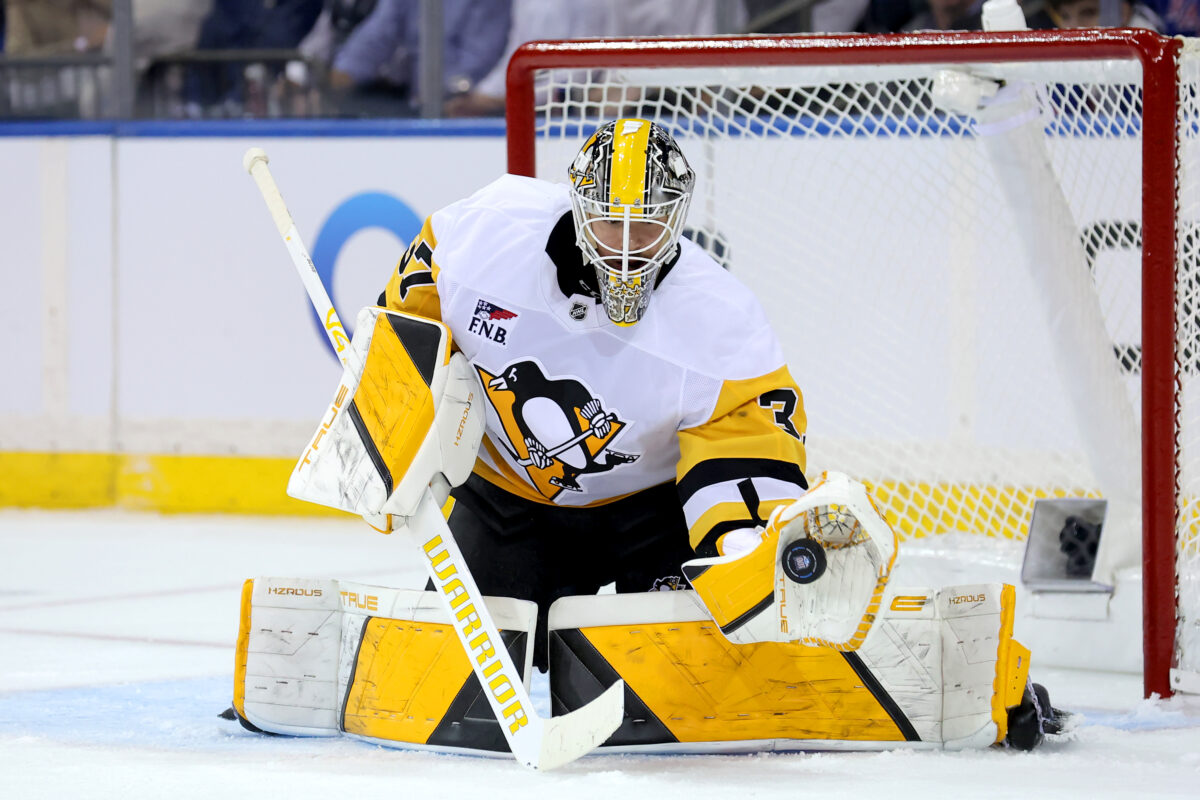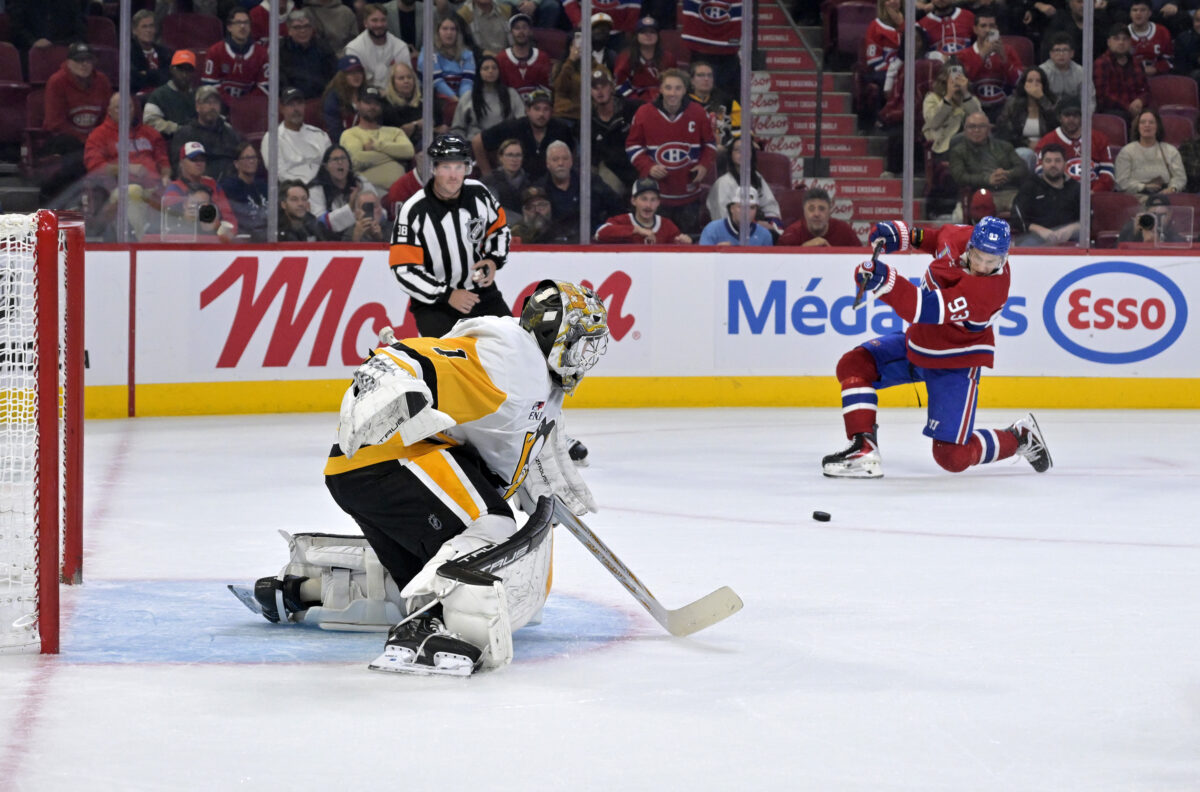For years, the Pittsburgh Penguins have been defined by elite talent at almost every position, but goaltending has often been the variable that determined how far the team could realistically go. That narrative has shifted this season. Instead of searching for answers in net, the Penguins suddenly find themselves with an unexpected surplus. With Tristan Jarry, Sergei Murashov, and Arturs Šilovs all delivering solid performances in their respective opportunities, Pittsburgh now has the rare luxury of surplus stability in goal. While that depth is a positive on the surface, it also creates an unavoidable question: how long can the Penguins realistically carry three legitimate NHL-caliber goaltenders?
Related: Oilers Reportedly Have Significant Interest in Penguins’ Tristan Jarry
On paper, the answer feels simple — ride the hot hand, keep everyone around, and let competition drive better performance. But in the modern NHL, where the salary cap dictates nearly every roster decision, surplus often creates pressure rather than comfort. The Penguins are now sitting in a position of leverage, and the logical way to maximize that leverage is by trading Jarry while his value is climbing again.
A Snapshot of the Penguins’ Goaltending Depth
The Penguins’ current goalie trio has all posted competitive numbers, reinforcing just how real this logjam is. Jarry, through eight games and 475 minutes of action, has delivered a 2.53 goals-against average (GAA) with a .914 save percentage (SV%). Murashov has impressed even more in a smaller sample, recording a 1.90 GAA and a .913 SV% across four games. Šilovs, who has carried the largest workload with 11 appearances and 635 minutes played, sits with a 2.74 GAA and a .907 SV%.

Those numbers tell a clear story: none of Pittsburgh’s goaltenders are actively hurting the team. Even more importantly, none of them look like a temporary stopgap. Jarry remains the most established option, but both Murashov and Šilovs have shown enough composure, athleticism, and consistency to handle NHL action when called upon. This is no longer a situation where one goalie is carrying the rest. It is a true internal competition — and that gives the Penguins options.
Tristan Jarry’s Value May Never Be Higher
Jarry’s tenure in Pittsburgh has been a roller coaster. At his peak, he was viewed across the league as a legitimate Vezina-caliber goaltender capable of carrying a contender through a long playoff run. At his lowest point, inconsistency and injuries severely damaged both his confidence and his trade value. Now, however, Jarry appears to be back on the positive side of that equation (From ‘Tristan Jarry’s redemption tour resumes as Penguins hold off Sabres: 10 observations’ – The Athletic, 11/27/2025).
A .914 SV% behind a Penguins team that has had its share of defensive breakdowns sends a strong message around the league. He looks composed again. His rebound control has improved, he is tracking pucks well through traffic, and the goals he is allowing are far more often the product of odd-man rushes and broken coverage than technical flaws in his game. Perhaps most important of all, the confidence has returned — and confidence drives perception for goaltenders as much as raw performance does.
Goalie markets are notoriously unpredictable. An injury or a poor month can crater trade value overnight. Right now, Jarry’s stock is trending upward, and that creates a small but meaningful window for Pittsburgh to act before that pendulum swings again.
Why the Goalie Logjam Is Actually a Competitive Advantage
Depth in net is no longer just about durability — it is about asset management. The Penguins are no longer choosing between a starter and a question mark. They are choosing between three viable options with tangible market value.
Murashov has been one of the more quietly impressive storylines of the season. His sub-2.00 GAA is not a fluke, and his .913 SV% reflects genuine consistency rather than sheltered usage. His positioning is disciplined, his lateral movement controlled, and he has shown comfort playing through sustained pressure. For a goaltender with limited NHL experience, that level of poise speaks volumes about his long-term outlook.
Silovs, meanwhile, brings size, athletic ability, and the mental toughness that is required to survive extended NHL stretches. His numbers are slightly lower than Murashov’s, but they remain well within starter territory — especially given his workload. Most notably, Šilovs has demonstrated the ability to rebound quickly after difficult games, a critical trait for any goaltender expected to play meaningful minutes over a full season.
Together, Murashov and Šilovs give the Penguins something they simply have not had in years: real internal competition without a massive performance drop-off. That alone makes trading Jarry not only possible, but strategically sound.
The Salary-Cap Reality Forces a Decision
As much as hockey decisions are framed around wins and losses, the salary cap ultimately dictates sustainability. Jarry’s contract represents the largest financial commitment of the three goaltenders. Keeping him long term while also trying to maintain depth throughout the lineup tightens Pittsburgh’s flexibility at a time when every dollar matters.

Moving Jarry allows the Penguins to free up cap space that can be reinvested where the roster needs it most. That cap relief could be redirected toward stabilizing the blue line, adding speed to the bottom six, or even preparing for future contract extensions. Cap space is not just about money — it is about options. For a Penguins team trying to stay competitive while carefully managing the twilight years of its core, flexibility is invaluable.
The Trade Market Is Ripe for Goaltending
Every season, multiple teams discover too late that their goaltending simply is not good enough. Whether it is due to injuries, failed tandems, or prolonged underperformance, contenders and fringe playoff teams are constantly searching for reliable stability between the pipes. Jarry fits that demand perfectly.
He is experienced, playoff tested, and capable of handling a starter’s workload immediately. For teams that cannot afford to gamble on unproven goaltenders, Jarry represents a known commodity. That type of certainty is extremely valuable at the NHL trade table. Even with a cap hit attached, a calm and stable starter is often worth paying for if it provides clarity at the most important position on the ice.
Why Keeping All Three Isn’t the Best Long-Term Path
While the idea of keeping three capable goalies may seem appealing, it is not a sustainable long-term strategy. Development requires playing time. Murashov and Šilovs both need consistent starts to continue growing into NHL starters. Keeping Jarry limits those opportunities. At the same time, reducing Jarry to limited usage risks hurting both his rhythm and his trade value.
Eventually, one of three things happens: a goalie becomes frustrated with limited usage, trade value erodes due to inactivity or inconsistency, or injuries force reactionary decisions rather than proactive ones. None of those outcomes benefit Pittsburgh. Decisive asset management now prevents those issues from surfacing later under worse circumstances.
Reinvesting Jarry’s Value Where It Matters Most
Trading Jarry is not about weakening the roster — it is about redistributing value to areas that need reinforcement. The Penguins’ biggest long-term concerns are already clear: defensive depth, increased team speed, and a gradual transition plan behind an aging core.
Jarry’s trade value offers a legitimate pathway to addressing those needs without sacrificing future flexibility. Whether that return comes in the form of lineup-ready defensemen, cost-controlled prospects, or high draft capital, it directly supports long-term competitiveness rather than short-term patchwork solutions.
The Psychological Shift in Net
There is also a mental and stylistic shift that comes with committing to the next generation of goaltenders. Younger netminders often play a more aggressive, athletic style that can influence how an entire team defends. That changes how the Penguins approach puck retrievals, neutral-zone pressure, and defensive rotations.
By transitioning to Murashov and Šilovs in full-time roles, Pittsburgh would not just be moving on from a contract — it would be shaping the next version of its defensive identity. That shift becomes increasingly important as veteran skaters age and the team evolves structurally.
A Rare Opportunity the Penguins Must Seize
The Penguins rarely find themselves in a position of goaltending excess. More often than not, they have been searching for solutions instead of choosing between them. That is what makes this moment significant.
Jarry is playing well.
Murashov is emerging.
Šilovs is proving reliable under pressure.
That combination creates leverage, and leverage is meant to be used. Trading Jarry while his value is high is not a commentary on his talent — it is a calculated recognition of timing, economics, and long-term roster direction. Pittsburgh can protect its present while investing in its future without creating instability in net.
In a league where goalie markets can swing dramatically with a single stretch of games, the Penguins are holding an asset at precisely the right moment. The smartest play is not waiting to see what happens.
It is acting before circumstances force their hand.
